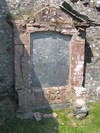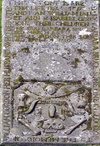| 1754 tomb St Johns Gamrie |
|---|

A slightly vernacular attempt at a Classical monument, the red sandstone pediment and architrave are literally falling apart. The inscription reads "Here lies interred the ashes of Margaret _____ Spouse to John Ord at ____ Crivie who died Jan the_ _ 1754. As also the ashes of Margaret Watt Spouse to John Ord sometime att Mill of Melross who died Jan the 7th 1707. |
| Bruce-Gordon tomb St Johns kirk Gamrie |

A typical early 18th cent grave slab with momenti mori, there are so many of these we stop noticing them but they are in their way not only remarkable works of art but also if legible historic records that tell poignant tales of the lives of our ancestors. |
| Coat of arms Gardenstown public hall |

A very deteriorated primitive hand painted coat of arms and sign. More Information |
| Emma Margaret Brigstocke memorial Gardenstown |

A simple and restrained granite monument to a grandmother, the inscription reads: "Erected by Francis William Garden Campbell of Troup and Glenlyon 1878 in memory of his mother's mother Emma Margaret Brigstocke who died August 20 1876 Psalm XCIII VER 3. 4." |
| GAMRIE WAR MEMORIAL |

It has a needle obelisk sitting on a small three-stepped plinth above a solid rectangular base, the sides of which bear the inscriptions. At the base, on each corner, is a small rectangular projection above which sit carved scrolls running up the corners. The whole monument sits on a one-step base within a small walled enclosure above which is a low iron fence. There are two World War I war graves in the churchyard also. Commemorates the dead of both World War I & II. More Information |
| Pies for parking |

An example of that much favoured genre of vandalistic intervention that involves removing or adding to official signage text to say something more amusing or profound, in this case with a certain wit. More Information |
| St Johns Kirk Gamrie |

The ruined church of St Johns; the ruins of former parish church dedicated to St John the Evangelist said to be founded in 11thC. The present church has been built in two periods at least, the east end probably early 16thC and the rest 17thC; measures 28.75m long by 4.72m wide; rubble built, gable ends; wall and gable remain to roof height; ambry in E wall; 16thC Barclay of Tolly monument; 17thC onwards monuments in churchyard; fell in to ruin mid 19thC when new parish church built in 1830. Repointed in 1961. |
This content was submitted by external contributors and does not necessarily reflect the views of the University of Aberdeen.
